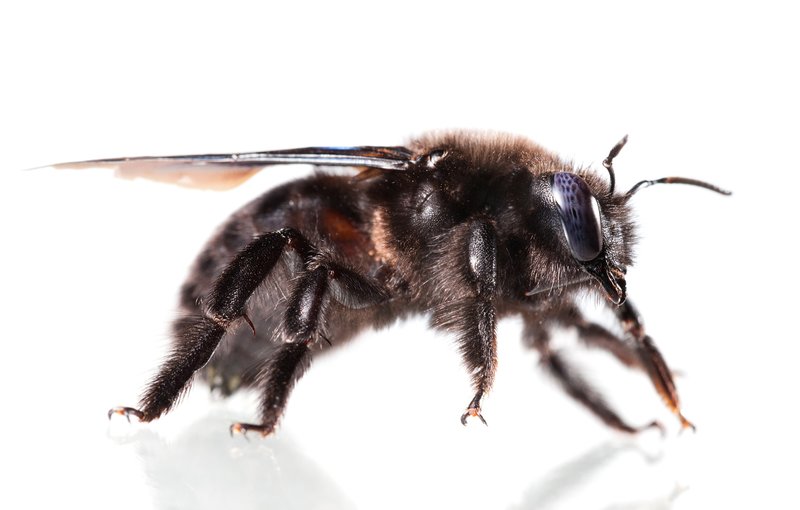
So, you think you may have a carpenter bee problem? Here are some simple facts to help you know if your unwanted guests are indeed carpenter bees.
First: What Are Carpenter Bees?
Although frequently mistaken for bumblebees, carpenter bees are very different from their relatives. The carpenter bee is one of many species of bees that belong to the Xylocopa genus. Carpenter bees get their name from their unique nesting habits. This destructive pest usually builds its nest out of natural, unfinished wood and can cause expensive damage to your property. Although all under one name, there are many types of carpenter bees across the globe. You may have also heard them referenced by their other nicknames: wood bees, wood boring bees, mason bees, termite bees and even big black bees.
Second: What Does a Carpenter Bee Look Like?
Carpenter bees resemble large bumble bees. The first characteristic that distinguishes them from the bumble bee is the smooth blackish-blue-colored abdomen. The thorax is where the common yellow, orange and white hairs are, along with dark thick hair on the legs. Carpenter bees can range from ¾” to 1” (1.9 to 2.54 cm) in length. The female carpenter bees can be easily distinguished from the males. Females have a pure black head, while the male heads have white markings. Carpenter bees are considered to be docile, meaning they very rarely sting unless provoked. However, only one of the genders has a stinger. To learn which carpenter bee to avoid and the difference between appearance and behavior between genders in carpenter bees, head over to our Male Vs Female Carpenter Bee blog post for more detailed information.

Third: What Do Carpenter Bee Holes Look Like?
These holes are usually ½” diameter in any softer wood. It is more than common for these nests to be 2 or more feet long with multiple sub-channels branching off the main tunnel. These holes might come with a yellow hint at the bottom of them or a guardian carpenter bee buzzing around the outside of these holes. This bee will usually not sting as it does not have a stinger, but will do whatever is deemed necessary to protect its nest. Along with a ½” hole and yellow tint near the hole, wood shavings at the base of the wooden structure can usually be a good indication of carpenter bee infestation.
Learn all of the tips and tricks we have acquired over the years with our How to Repair Carpenter Bee Holes guide on how to simply and effectively fill carpenter bee holes.
How Do Carpenter Bees Drill Holes?
Carpenter bees love to make holes in untreated wood. The holes are part of their nest, known as a gallery. Their preferred homesite is softwood like pine, redwood and cedar. They use their mouthparts, called mandibles, to chew or “drill” through the wood. They can drill through an inch of wood in 5 or 6 days, but they don’t eat it. Instead, they drill their holes and leave the sawdust behind – one of the first signs of a carpenter bee problem. If you see small piles of sawdust, look closer to see if you have carpenter bee holes.
Fourth: When Would You Find Carpenter Bees?
Carpenter bees are most active during the spring. This can vary depending on where you live, as carpenter bee seasonality differs by your location. This is when they emerge from their nests and start their mating and nesting process over again. It is important to be vigilant of any carpenter bee nests before real problems arise. Best Bee Traps hung by your roof and porch will draw the carpenter bees away from nesting in your exposed wood. These traps are specifically designed to attract the carpenter bee and trap them in a convenient plastic bottle. The Best Bee Trap is simple to use and guaranteed to catch carpenter bees!












4 comments
John Hughes
The bee trap works great I first had to catch one and put it in the Trap after I did that within a day or two I had three more bees in the trap great purchase
Customer Support
@WAQUAR AHSAB – Good question! Physically, the male and female bees look almost alike. The key difference is the markings on their heads. Males have small white markings, and the females have pure black heads.
WAQUAR AHSAB
Are the males completely black and the females yellow and black?
jeffrey.
thank you for your best bee product. I ordered 2 ea in april 2016 1 for my front porch.and 1 for my rear deck. in two weeks I have traped 12 to 15 bees.great product. Jeffrey Amanda,ohio.
Leave a comment
All comments are moderated before being published.
This site is protected by hCaptcha and the hCaptcha Privacy Policy and Terms of Service apply.